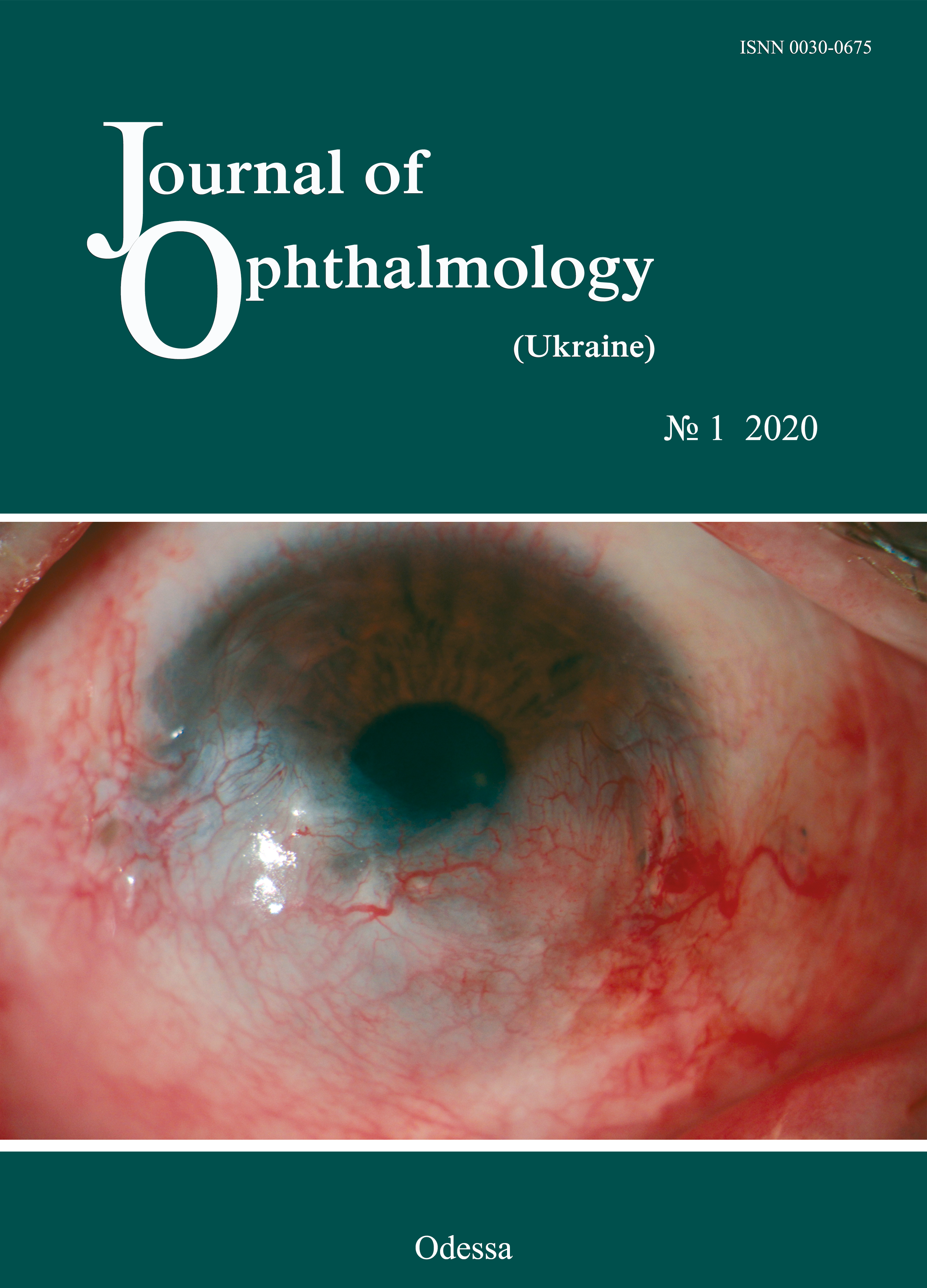Treatment of rhegmatogenous retinal detachment: from the past to the future
DOI:
https://doi.org/10.31288/oftalmolzh202014048Keywords:
vitrectomy, silicone oil, gas tamponade, rhegmatogenous retinal detachment, hydrogel, viscosurgeryAbstract
Rhegmatogenous retinal detachment (RRD) is a severe disorder that can potentially lead to blindness. The traction developing in pathological attachment of the vitreous to retinal degeneration areas and in posterior hyaloid detachment leads to formation of retinal breaks and subsequent retinal detachment. The approach to treatment of RRD has changed with years from cautery (J. Gonin, 1920) to modern vitrectomy (R. Machemer, 1973). Current advances in vitrectomy are related mostly to the three major fields: development of advanced vitrectomy tools, novel operative techniques and tamponade agents. The tamponade agents used in vitrectomy have specific advantages and disadvantages. Therefore, new solutions are being sought to minimize harmful effects of tamponade agents on ocular tissues, which would make the process of rehabilitation more comfortable for patients. In recent decades, the potential for using hydrogels as a substitute to the vitreous removed during vitrectomy has been actively explored (Widder, 1960, Balazs, 1972, Malson, 1985). The first commercially available biomedical sodium hyaluronate product for use in eye surgery, Healon, was developed by Balazs. Although Healon was developed as a vitreous substitute, it has been successfully used also in cataract surgery, and truly initiated the age of viscosurgery. The research on the potential for using hydrogels as a visual substitute is underway.
References
1.Mitry D, Charteris DG, Fleck BW, Campbell H, Singh J. The epidemiology of rhegmatogenous retinal detachment: geographical variation and clinical associations. Br J Ophthalmol. 2010 Jun 9; 94(6):678-6. https://doi.org/10.1136/bjo.2009.157727
2.Zakharov VD. [Retinal detachment surgery]. [Abstract of Dr Sc (Med) Dissertation]. Moscow: MNTK Eye Microsurgery; 1985. Russian.
3.Osmanov RE. [Prevalence of rhegmatogenous retinal detachment in Tambov region]. Vestnik TGU. 2015;20(6):1666-8. Russian. URL: https://cyberleninka.ru/article/v/rasprostranennost-regmatogennoy-otsloy.
4.Park SJ, Choi NK, Park KH, Woo SJ. Five year nationwide incidence of rhegmatogenous retinal detachment requiring surgery in Korea. PLoS One. 2013 Nov 13; 8(11): e80174. https://doi.org/10.1371/journal.pone.0080174
5.Sebag J. Anatomy and pathology of the vitreo-retinal interface. Eye. 1992 Nov 1; 6, 541-552 https://doi.org/10.1038/eye.1992.119
6.Simone D, Caprani SM, Airaghi G, Vinciguerra R, Bartalena L, Testa F, Mariotti C, Porta G, Simonelli F, Azzolini C. Vitreous Substitutes: The Present and the Future. BioMed Research International. 2014 May 4; 2014, 12.https://doi.org/10.1155/2014/351804
7.Vit VV. [The structure of the human visual system]. Odessa: Astroprint; 2010. Russian.
8.Balazs EA, Laurent TС, Laurent UBG. Studies on the structure of the vitreous body. VI. Biochemical changes during development. J Biol. Chem. 1959 Feb; 234(2):422-8.https://doi.org/10.1016/S0021-9258(18)70317-7
9.Sebag J. The Vitreous - Structure, Function, and Pathology. N.Y.: Springer; 1989.https://doi.org/10.1007/978-1-4613-8908-8
10.Hench L, Jones J. Biomaterials, Artificial Organs and Tissue Engineering. 1 ed. London: Woodhead Publishing; 2005.https://doi.org/10.1533/9781845690861.1
11.Boiko EV, Maltsev DS, Suetov AA. [Posterior hyaloid detachment: concept, prevalence, classifications, and possible causes]. Oftalmologicheskiie vedomosti. 2009; 2(3):39-47. Russian. https://cyberleninka.ru/article/n/otsloyka-zadney-gialoidnoy-membrany-po.
12.Zakharov VD. [Vitreoretinal surgery]. Moscow: Moscow; 2003. Russian. https://www.twirpx.com/file/519398/.
13.Lin Т, Mieler WF. Management of primary rhegmatogenous RD [Internet]. Chicago: Rev. Ophthalmol. Online; 2008 July 15. Available from: http://www.reviewofophthalmology.com/content/d/retinal_insider/i/1226/c/.
14.Arroyo JG, Yang L, Bula D, Chen DF. Photoreceptor apoptosis in human retinal detachment. Am J Ophthalmol. 2005 Apr.; l39(4): 605 5. https://doi.org/10.1016/j.ajo.2004.11.046
15.Galimova AB. [Evolution of approaches to management of rhegmatogenous retinal detachment]. Oftalmologicheskiie vedomosti. 2011; 4(3):70-7. Russian. URL: https://cyberleninka.ru/article/v/evolyutsiya-podhodov-k-hirurgicheskomu.
16.Rumiantseva AF. [Eye surgery]. Kyiv: Gostmedizdat USSR; 1957. Russian.
17.Kreissig I. [Development of Retinal Detachment Surgery: How it came about and what we are doing now (part I)]. Russkii meditsinskii zhurnal. 2007; 8(4):163-7. Russian.
18.Kreissig I. A Practical Guide to Minimal Surgery for Retinal Detachment, Volume 1: Diagnostics, Segmental Buckling without Drainage, Case Presentations. 1st ed. New York: Thieme; 2000.https://doi.org/10.1055/b-002-52060
19.Ahmadieh H, Moradian S. et al. Anatomic and visual outcomes of sclera buckling versus primary vitrectomy in pseudophakic and aphakic retinal detachments. Ophthalmology. 2005 Aug;112(8):1421-4. https://doi.org/10.1016/j.ophtha.2005.02.018
20.Lincoff H, Coleman J, Kreissig I, et al. Theperfluorocarbongases in the treatment of retinal detachment. Ophthalmology. 1983 May;90(5):546-5. https://doi.org/10.1016/S0161-6420(83)34525-5
21.Machemer R. Buettner H, Norton EW, Parel JM. Vitrectomy: a pars plana approach. Trans Am Acad Ophthalmol Otolaryngol. 1971 May;75(4):813-7. PMID:4667660.
22.Schneider E, Schneider E, Geraets R, Johnson M. Pars plana vitrectomy without adjuvant procedures for repair of primary rhegmatogenous retinal detachment. Retina. 2012 Feb; 32(2):213-6. https://doi.org/10.1097/IAE.0b013e3182278b29
23.Arya AV, Emerson JW, Engelbert M, Hagedorn C, Adelman RA. Surgical management of pseudophakic retinal detachment: A meta-analysis. Ophthalmology. 2006 Oct;113(10):1724-8. https://doi.org/10.1016/j.ophtha.2006.05.044
24.Maliatsinskii IA. [Clinical and functional substantiation of the technique for microinvasive surgical treatment of recurrent inferior retinal detachment during intravitreal silicone oil tamponade]. [Abstract of Cand Sc (Med) Thesis]. Moscow: MNTK Eye Microsurgery; 2015. Russian. URL: http://www.mntk.ru/files/upload/avtoreferat-malyatsinskiy.pdf.
25.Rozhko et al. [Efficacy of extrascleral surgery with pneumatic retinopexy with sulfur hexafluoride (SF6) for rhegmatogenous retinal detachment]. Rossiiskaia oftalmologiia on-line. 2009. URL: article.aspx.
26.Norton EWD, Aeberg T, Fung W, Curtin VT. Giant retinal tears. I. Clinical management with intravitreal air. Am J Ophthalmol. 1969; 68(6):1011-10.https://doi.org/10.1016/0002-9394(69)93441-2
27.Lincoff A, Kriessig I. Intravitreal behavior of perfluorocarbons. Dev Ophthalmol. 1981; 2: 17-6. https://doi.org/10.1159/000395297
28.Sandner D, Engelmann K. First experiences with high-density silicone oil (Densiron) as an intraocular tamponade in complex retinal detachment. Graefe's Arc Clin Exp Ophthalmol. 2006 May; 244(5): 609-10. https://doi.org/10.1007/s00417-005-0110-8
29.Zhmurik DV. [Effect of 30 day tamponade using perfluorocarbon liquid on the bioelectric functional activity and structure of the retina in rabbits]. J Ophthalmol (Ukraine). 2016; 1(468): 58-7. Russian. http://nbuv.gov.ua/UJRN/Ofzh_2016_1_15.
30.Lyskin PV, Kazimirova EG, Perepukhov AM. [Physical and chemical aspects of double intravitreal tamponade with PFCL and SO]. Oftalmokhirurgiia. 2014; 1: 64-7. Russian. URL: https://doi.org/10.25276/0235-4160-2014-1-64-67.
31.Kleinberg TT, Tzekov RT, Stein L, Ravi N, Kaushal S. Vitreous substitutes: a comprehensive review. Survey of Ophthalmology. 2011 May 24;56(4):300-23. https://doi.org/10.1016/j.survophthal.2010.09.001
32.Gao Q, Mou S, Ge J, et al. A new strategy to replace the nanural vitreous by a novel capsular artificial vitreous body with pressure-control valve. Eye. 2008 Apr;22(3):461-8. https://doi.org/10.1038/sj.eye.6702875
33.Leparskaia NL. [Role of proliferative vitreoretinopathy in the pathogenesis, clinical picture and treatment of traumatic retinal detachment (clinical and experimental study)]. [Abstract of Cand Sc (Med) Thesis]. Moscow: MNTK Eye Microsurgery; 2005. Russian. URL: https://www.dissercat.com/content/eksperimentalnoe-obosnovanie-fotodinam.
34.Cutler N.L. Transplantation of human vitreous: a preliminary report. Arch Ophthal. 1946 June; 35(6):615-8. https://doi.org/10.1001/archopht.1946.00890200630002
35.Petrov SIu, Mazurova IuV, Aslamazova AE, et al. [Use of viscoelastics in eye surgery]. Natsionalnyi zhurnal glaucoma. 2016; 15(1): 97-104. Russian.
36.Balazs EA. Physical chemistry of hyaluronic acid. Fed Proc. 1958 Dec; 17(4):1086-7. PMID:13619778.
37.Balazs EA, Freeman MI, Kloti R, Meyer-Schwickerath G, Regnault F, Sweeney DB. Hyaluronic acid and replacement of vitreous and aqueous humor. Mod Probl Ophthalmol. 1972; 10(3):21. PMID:4626802.
38.Miller D, Stegmann R. Healon. A guide to its use in ophthalmic surgery. New York: John Wiley; 1983.
39.Malson T, Lindqvist BL, inventors; PHARMACIA AB., assignee. Gel of crosslinked hyaluronic acid for use as a vitreous humor substitute. United States patent US 4716154A. 1984 Jan 08.
40.Suri S, Banerjee R. In vitro evaluation of in situ gels as short term vitreous substitutes. J Biomed Mater Res A. 2006 Dec 1;79(3):650-14. https://doi.org/10.1002/jbm.a.30917
41.Inoue M, Iriyama A, Kadonosono K, Tamaki Y, Yanagi Y. Effects of perfluorocarbon liquids and silicone oil on human retinal pigment epithelial cells and retinal ganglion cells. Retina. 2009 May;29(5):677-4.https://doi.org/10.1097/IAE.0b013e318196fca1
42.Ichhpujani P, Jindal A, Katz J. Silicone oil induced glaucoma: A review. Graefes Arch Clin Exp Ophthalmol. 2009 Dec;247(12):1585-8.
https://doi.org/10.1007/s00417-009-1155-x
43.Ahmadieh H, Moradian S. et al. Anatomic and visual outcomes of sclera buckling versus primary vitrectomy in pseudophakic and aphakic retinal detachments: six-month follow-up results of a single operation--report no. 1. Ophthalmology. 2005 Aug;112(8):1421-8.https://doi.org/10.1016/j.ophtha.2005.02.018
44.Soloviova EP. [Silicone distribution in ocular tissue after vitrectomy with replacement using silicone oil]. Oftalmologicheskiie vedomosti. 2012; 5(1):18-21. Russian.
45.Sigler EJ, Randolph JC, Charles S, Calzada JI. Intravitreal fluorinated gas preference and occurrence of rare ischemic postoperative complications after pars plana vitrectomy: a survey of the American Society of Retina Specialists. J Ophthalmol. 2012 Sep 11; 2012:230596-5.https://doi.org/10.1155/2012/230596
46.Lincoff H, Weinberger D, Stergiu P. Air travel with intraocular gas. II. Clinical considerations. Arch Ophthalmol. 1989 Jun;107(6):907-3.https://doi.org/10.1001/archopht.1989.01070010929043
47.Malucelli G, Malucelli G, Dore J, Sanna D, Nuvoli D, Rassu M, Mariani A, Alzari V. Sliding Cross-linked Thermoresponsive Materials: Polypseudorotaxanes Made of Poly(N-Isopropylacrylamide) and Acrylamide-?-Cyclodextrin. Fronti Chem. 2018 Nov 23;6:585. https://doi.org/10.3389/fchem.2018.00585
48.Sara S, Hutter V, Brown MB, Cook MT, DYS Chau. Diffusion through the ex vivo vitreal body - Bovine, porcine, and ovine models are poor surrogates for the human vitreous. Int J Pharm. 2018 Oct 25;550(1-2):207-8.https://doi.org/10.1016/j.ijpharm.2018.07.070
49.Hoffman AS. Hydrogels for biomedical applications. Adv Drug Deliv Rev. 2002 Jan 17;54(1):3-9. DOI:10.1016/s0169-409x(01)00239-3.https://doi.org/10.1016/S0169-409X(01)00239-3
50.Wichterle O, L?m D. Hydrophilic gels for biological use. Nature. 1960 Jan 09;185:117-1. https://doi.org/10.1038/185117a0.https://doi.org/10.1038/185117a0
51.Kope?ek J, Yang J. Hydrogels as smart materials. Polym Int. 2007 Sep; 56(9):1078 -20. DOI: 10.1002/pi.2253.https://doi.org/10.1002/pi.2253
52.Khmelnitskii SI, Lesovoi DE. [Prospects for the use of superporous polyvinyl alcohol-based hydrogels and their composites in novel medical technologies]. Novosti meditsiny i farmatsii. 2008; (3):234. Russian.
53.Yahia LH, Chirani N, Gritsch L, et al. History and Applications of Hydrogels. J Biomedical Sci. 2015 Dec; 4:1-23. https://doi.org/10.4172/2254-609X.100013
54.Petrov SIu, Mazurova IuV, Aslamazova AE, et al. [Use of viscoelastics in eye surgery]. Natsionalnyi zhurnal glaucoma. 2016; 15(1): 97-104. Russian. URL: https://www.glaucomajournal.ru/jour/article/viewFile/164/163.
55.Wolf KJ, Kumar S. Hyaluronic Acid: Incorporating the Bio into the Material [Internet]. ACS Biomater Sci Eng; 2019 Jan 27. Available from: https://pubs.acs.org/doi/full/10.1021/acsbiomaterials.8b01268. https://doi.org/10.1021/acsbiomaterials.8b01268
56.Dicker KT, Gurski LA, Pradhan-Bhatt S, Witt RL, Farach-Carson MC, Jia X. Hyaluronan: A Simple Polysaccharide with Diverse Biological Functions. Acta Biomater. 2014 Apr; 10(4):1558-12. https://doi.org/10.1016/j.actbio.2013.12.019
57.Stern R. Hyaluronan Catabolism: A New Metabolic Pathway. Eur J Cell Biol. 2004 Aug;83(7):317-8.https://doi.org/10.1078/0171-9335-00392
58.Ponta H, Sherman L, Herrlich PA. CD44: From Adhesion Molecules to Signalling Regulators. Nat Rev Mol Cell Biol. 2003 Jan;4(1):33-12.
https://doi.org/10.1038/nrm1004
59.Baino F. Towards an ideal biomaterial for vitreous replacement: historical overview and future trends. Acta Biomaterialia. 2011 Mar;7(3):921-14.https://doi.org/10.1016/j.actbio.2010.10.030
60.Liang C, Peyman GA, Serracarbassa P, Calixto N, Chow AA, Rao P. An evaluation of methylated collagen as a substitute for vitreous and aqueous humor. Int Ophthalmol. 1998;22(1):13-5. https://doi.org/10.1023/A:1006016809070
61.Barth H, Crafoord S, O'Shea TM, Pritchard CD, Langer R, Ghosh F. A new model for in vitro testing of vitreous substitute candidates. Graefes Arch Clin Exp Ophthalmol. 2014 Oct; 252(10):1581-11. https://doi.org/10.1007/s00417-014-2714-3
62.Kope?ek J. Hydrogel biomaterials: a smart future? Biomaterials. 2007;28(34):5185-7. https://doi.org/10.1016/j.biomaterials.2007.07.044
63.Yu Y, Lin X, Wang Q, He M, Chau Y. Long-term therapeutic effect in nonhuman primate eye from a single injection of anti-VEGF controlled release hydrogel. Bioeng Transl Med. 2019 May; 4(2):e10128. https://doi.org/10.1002/btm2.10128
64.Osswald CR, Kang-Mieler JJ. Controlled and extended in vitro release of bioactive anti-vascular endothelial growth factors from a microsphere-hydrogel drug delivery system. Curr Eye Res. 2016 Sep; 41(9): 1216-6. https://doi.org/10.3109/02713683.2015.1101140
65.Ding SSL, Subbiah SK, Khan MSA, Farhana A, Mok PL. Empowering Mesenchymal Stem Cells for Ocular Degenerative Disorders. Int J Mol Sci. 2019 Apr;20(7):1784.https://doi.org/10.3390/ijms20071784
66.Su WY, Chen KH, Chen YC, Lee YH, Tseng CL, Lin FH. An injectable oxidated hyaluronic acid/adipic acid dihydrazide hydrogel as a vitreous substitute. J Biomater Sci, Polym Ed. 2011;22(13):1777-20. https://doi.org/10.1016/j.actbio.2016.07.051
67.Santhanam S, Lianga J, Struckhoffac J, Hamilton PD, Ravi N. Biomimetic hydrogel with tunable mechanical properties for vitreous substitutes. Acta Biomater. 2016 Oct 1;43: 327-10. https://doi.org/10.1016/j.actbio.2016.07.051
68.Barth H, Crafoord S, Andr?asson S, Ghosh F. A cross-linked hyaluronic acid hydrogel (Healaflow(®)) as a novel vitreous substitutе. Graefes Arch Clin Exp Ophthalmol. 2016 Apr; 254(4):697-6. https://doi.org/10.1007/s00417-015-3256-z
69.Schnichels S, Schneider N, Hohenadl C, Hurst J, Schatz A, Januschowski K, Spitzer MS. Efficacy of two different thiol-modified crosslinked hyaluronate formulations as vitreous replacement compared to silicone oil in a model of retinal detachment. PLoS One. 2017 Mar 1;12(3)e0172895 https://doi.org/10.1371/journal.pone.0172895
70.Yu AC, Lee YJL, Eng LF. Astrogliosis in culture: I. The model and the effect of antisense oligonucleotides on glial fibrillary acidic protein synthesis. J Neurosci Res.1993 Feb 15;34(3):295-8. https://doi.org/10.1002/jnr.490340306
71.Januschowski K, Schnichels S, Hurst J, Hohenadl C, Reither C, Rickmann A, Pohl L, Bartz-Schmidt K, Spitzer MS. Ex vivo biophysical characterization of a hydrogel-based artificial vitreous substitute. PLoS One. 2019 Jan 7;14(1):e0209217
https://doi.org/10.1371/journal.pone.0209217
72.Schramm C, Spitzer S, Henke-Fahle S et al. The crosslinked biopolymer hyaluronic acid as an artificial vitreous substitute. Invest Ophthalmol Vis Sci. 2011 Dec; 53(2):613-8.https://doi.org/10.1167/iovs.11-7322
73.Gao Tsjan'in, inventor; GUANChZhOU VISBOR BIOTEKNOLODZhI LTD, Assignee. [A method of making collapsible artificial glass body and mould for this end]. Russian Federation Patent RU 2496641C2. Application: 2011118920/05, 30.03.2009. Date of publication: 27.10.2013, Bull. 30. https://patentimages.storage.googleapis.com/b1/f0/de/d355ec127361fa/RU24.
74.Koo H, Jin G-W, Kang H, et al. A new biodegradable crosslinked polyethylene oxide sulfide (PEOS) hydrogel for controlled drug release. Int J Pharm. 2009 Jun 5;374(1-2):58-7. https://doi.org/10.1016/j.ijpharm.2009.03.010
Downloads
Published
How to Cite
Issue
Section
License
Copyright (c) 2025 М. Ю. Кронгауз, І. О. Насінник, Н. В. Пасєчнікова

This work is licensed under a Creative Commons Attribution 4.0 International License.
This work is licensed under a Creative Commons Attribution 4.0 International (CC BY 4.0) that allows users to read, download, copy, distribute, print, search, or link to the full texts of the articles, or use them for any other lawful purpose, without asking prior permission from the publisher or the author as long as they cite the source.
COPYRIGHT NOTICE
Authors who publish in this journal agree to the following terms:
- Authors hold copyright immediately after publication of their works and retain publishing rights without any restrictions.
- The copyright commencement date complies the publication date of the issue, where the article is included in.
DEPOSIT POLICY
- Authors are permitted and encouraged to post their work online (e.g., in institutional repositories or on their website) during the editorial process, as it can lead to productive exchanges, as well as earlier and greater citation of published work.
- Authors are able to enter into separate, additional contractual arrangements for the non-exclusive distribution of the journal's published version of the work with an acknowledgement of its initial publication in this journal.
- Post-print (post-refereeing manuscript version) and publisher's PDF-version self-archiving is allowed.
- Archiving the pre-print (pre-refereeing manuscript version) not allowed.












